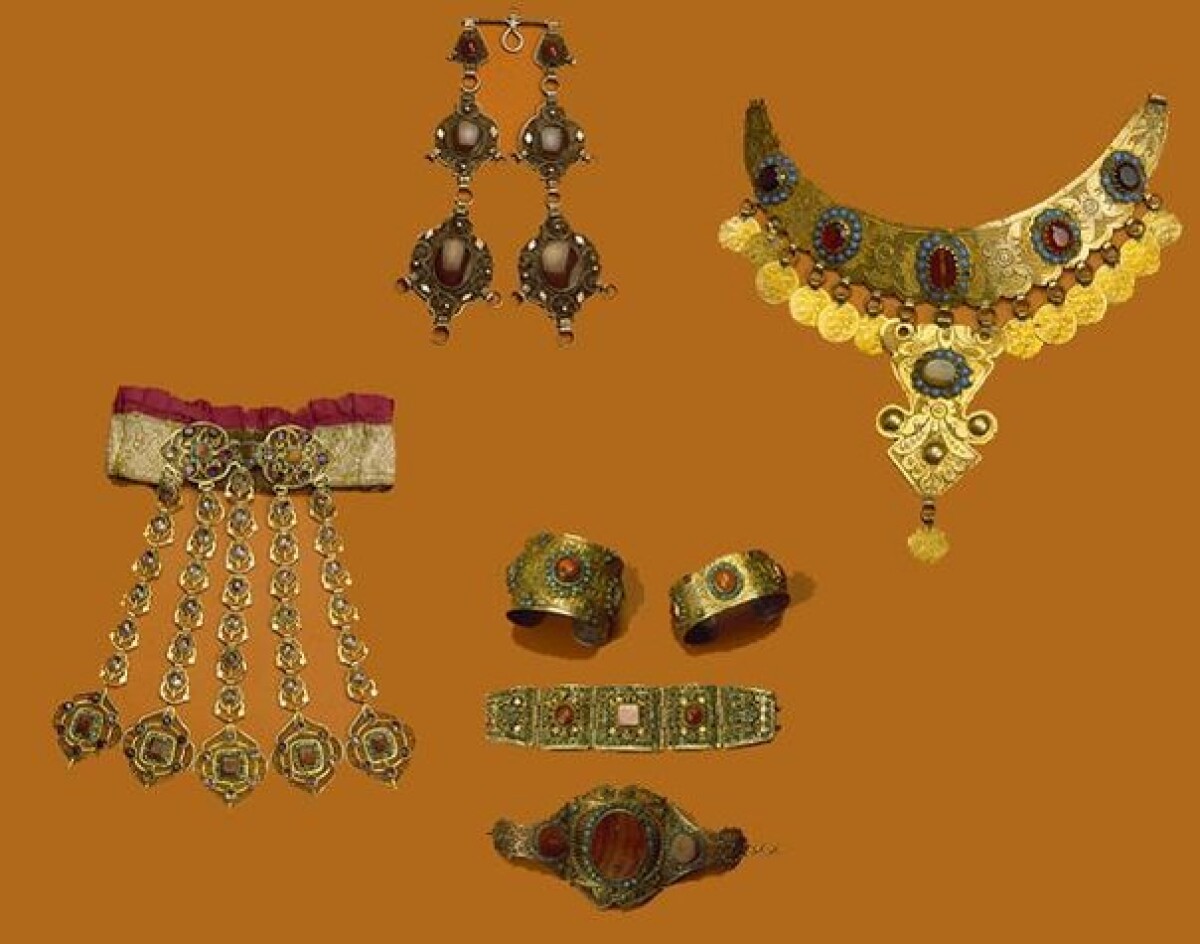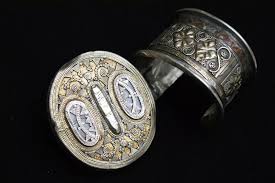
In comparison with other types of Kazakh applied art having the character of home works, jewelry was professional, which was preconditioned with the specificity of production.
In the history of Kazakh national culture jewelry art takes a special place, developed on the base of ancient traditions interacting with cultures of adjacent people. Kazakh jewelers — zergers («zer-zar» from Persian «gold») mostly worked alone, their skills were inherited. The master had a certain set of instruments: hammers (balga), jaws (iskenzhe), rasp files (egeu), scissors (kaishy), drill-machine (burgy), awl (biz), iron rectangular plate for stretching the silver wire (tesim temir), etc. Zerger also had a set of forms kalyp. Forms for producing earrings and other female jewelry differed with a special variety. There were forms according to which the bracelets were forged.
A number of items made by a zerger was huge; here were womanish jewelry, details for the costume, personal care items, cutlery, buckles for the design of a wooden carcass of the yurta, furniture, wooden and leather dishes, musical instruments, weapon, horse equipment.
As the material was used gold and more often silver. Zergers could delicately reveal beauty of the metal. In skillful hands silver shined differently, it was conceived alive. Jewelers furnished their items with precious stones (rubies, saphires, emeralds, diamonds, turquoise), also cornelian, agate, pearl, coral, nacre.
Among people there was a saying: «If a man does not know the crafts there will not be any use».
The craft of blacksmiths and jewelers was extremely honorable, and the smithery, especially, anvil were considered sacral. Women and girls do not have to enter the smithery or take any things out from there. Insane people were left to stay for night in the smithery as if for «healing».
The main production of zergers were womanish jewelry decorations being in a high demand not only because of natural aesthetic qualities , but also because of a number of functional meanings, connected with traditions, the whole idea-religious complex. Jewelry decorations were traditionally integral part of the national costume and accompanied a woman all her life.
Thus, a girl was put on during the first days after the birth considering that they fulfill the defending function. The amulet defending a child from an «evil eye» were also supposed to be the simplest bracelets made out of many-colored or entire precious beads with white spots. The decorations of boys and girls mainly were similar and differences in their set and look became obvious only from 5 years. With the age the set of decorations gradually increased.
Especially multiple and various were decorations for girls of 9-12 years old, when they were considered brides. The most numerous and complicated was the set of wedding decorations, which was worn till the birth of the first child.
Love for decorations was explained with a number of reasons. The first in the life of children decorations of both boys and girls serving the amulets did not simply turn aside the evil eye, but also played the role of amulets saving the life to a child. Each family wanted to have beautiful amulets, because the mortality of children was a mass disaster, and to have an extended breed was considered acceptable before Allah, and children were superstitiously saved.
When a girl became a bride, and then a young woman, her decorations were not only amulets (although they kept their own meaning), but also virtuous symbols, specifically expressing the ideas of fertility. Young girls and women paid a special attention to worn on the head and breast decorations saving the head and breast.

Every folk created the whole complex of decorations adherent to their viewpoint on beauty and harmony.
The peculiar features of Kazakh jewelry decorations are monumentality and almost sculpture expressiveness, kept even in small forms, rhythmic combination of the pattern and background, making the impression of the spatiality, symmetry in the location of patterns. The ability to underline the beauty and nobleness of metal were always adherent to Kazakh zergers.
Various in form ornamentations, Kazakh jewelry items as a whole are characterized with laconism and generality of art means. Material, form and décor of the item are in a complete balance, organic interconnection, that induces the wholeness and harmonious image.
In Kazakh jewelry art the material itself and the item since ancient times were holders of various superstitions and beliefs. Thus, for instance, the insertions out of stones among people are called «tas» (stone) or «koz» (eye).
The beliefs about amazing attributes of stones are widely spread among all the Eastern people.
For instance, the turquoise strengthens heart, removes fear, giver victory over enemies, pearl cures the wall-eye, coral defends from the evil and spell, turquoise brings happiness. Carnelian is considered the stone of wealth and joy.
The purifying and magic quality for Kazakhs had silver. Besides rings, to water for baby wash they threw silver coins with words: «Balanyn kuni kumistei zharyk bolsyn!» (Let the days of a child be bright as silver). Each woman has to wear a ring, otherwise, the food prepared by her would be not clean, on this occasion the saying was kept: «Tamak adal bolu ushin, kolda zhuzik bolu kerek» (to make the food clean, on the hand there should be a ring).
To the number of items symbolizing fertility relate fasteners and decorative badges with the motives of fish. The ideas of prosperity were expressed in the rings of kus muryn type (bird beak).
In the course of time in jewelry items the decorative side started dominating, their initial magic meaning continuously was lost, the aesthetic and festive functions in decorations dominate. Especially ornate looked the wedding ensemble of decorations. The headwear was decorated with jewelry items, coral, pearl, nacre beads, tied in some places with silver plates. The wedding gown was embroidered with coins, stones, silver, pearl buckles. With corals and pearl the rims of a dress were sewn, with silver badges were decorated leather and velvet belt and shoes, on breast they wore a necklace, on ears — earrings, hair was decorated with charms, on hands they put on bracelets and rings. Thus, a bride was dressed in shining because of silver and colorful stones gown.
The continuous decoration were earrings. A great popularity was among earrings-lunulas ay syrga, shygyrshyk syrga, zhuka seldir syrga. Rather attractive were earrings, the basis of which were inserted jems — koz tasty syrga. The obligatory attribute of the ladies’ accessories were rattling pendants decorating and simultaneously underlining the length and thickness of hair personifying young lady’s beauty.
An outstanding womanish decoration were considered bracelets (bilezik), but were rather various: round, square — zhumyr bilezik, in the form of a watch — sagat bilezik, bracelet with rings — bes bilezik, consisting of two-three parts, united pivotally — topsaly bilezik.
Everyday decorations were rings which differed with their diversity. The special interest represent rings with a caste in the form of spiral or grained cone otau zhuzik. The element of a game is present in a constructive decision of components of rings — riddles zhimaly zhuzik.
The peculiar interest evoke fasteners — kapsyrma, ilgek. Quite various are the forms of fasteners, which were extensive and flat. One of important components of traditional costume were the belts tightening a waist. Female belts were metal, but, more often with leather, velvet base.
A huge impression of glitter and brightness make belts with buckles furnished with blue and colorful enamel in complex with glittering. The set of decorations was added and strengthened with badges, buttons, doing up the neck of a dress and decorating the dress, buckles, pendants-amulets out of cornelian, colorful stones.
Kazakh zergers were skillful masters in the creation of jewelry gown of a horse. Here two types of craft — smithery and jewelry united. A blacksmith forged stirrups (uzengi), ornate coat of front and back saddlebow (aldyngy, artky kas), different forms of plates, buckle of horse harness, etc. These items were made either directly by the order of a jeweler, or people who bought them invited a zerger for a jewelry working of purchased items.
Zergers made silver combs (tarak) and toothpicks (tis shukysh), also different golden decorations.
Masters made forged chests for food and home things, bed, etc., decorating them with a cutting on metal and wood. Their items decorated hunting equipment such as tomaga (stand for a hunting bird), also musical instruments — asatayak, kobyz, dombra, sybyzgy, dauylpaz.
Cut plates made out of silver and bronze and braids served for a decoration of clothes, belts, leather galoshes, etc. These items were covered with traditional ornaments: stylized images of ram’s horns, camel foot, floral and geometric ornament. Many of them are original art works.
The items of Kazakh zergers keep invaluable works of applied and decorative art living through centuries and coming into our life together as something inseparable composing a part of spiritual wealth and being cultural heritage of our people.
Used material:
Dzhelbudin E.T. Traditsii i obychai kazahov. Adet — guryp. Traditions and customs of Kazakhstan.
Use of materials for publication, commercial use, or distribution requires written or oral permission
from the Board of Editors or the author.
Hyperlink to Qazaqstan tarihy portal is necessary. All rights reserved by the Law RK “On author’s rights
and related rights”.
To request authorization email to
or call to 8 (7172) 57 14 08 (in
- 1164)
